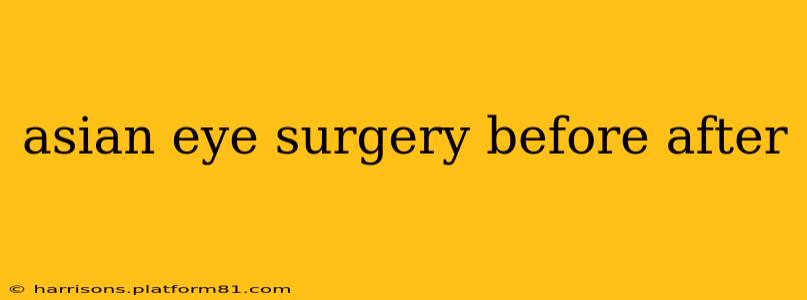Asian eyelid surgery, also known as blepharoplasty or double eyelid surgery, is a popular cosmetic procedure that alters the appearance of the eyelids. This guide will explore the before and after aspects of this surgery, addressing common questions and concerns. We'll delve into the procedure itself, recovery, potential risks, and how to find a qualified surgeon. Remember, this information is for educational purposes and does not constitute medical advice. Always consult with a qualified surgeon before making any decisions regarding cosmetic surgery.
What is Asian Eye Surgery (Blepharoplasty)?
Many individuals of Asian descent have what's often referred to as "monolid" eyes, meaning they lack a distinct crease in the upper eyelid. Asian blepharoplasty aims to create this crease, making the eyes appear larger and more defined. The procedure involves surgically creating a crease in the upper eyelid, sometimes involving the removal of excess skin and fat. The specific techniques employed vary depending on the individual's anatomy and desired outcome. There are several different types of incisions and techniques used, such as:
- Full incision blepharoplasty: This involves a full incision along the crease line, allowing for precise removal of excess skin and fat.
- Partial incision blepharoplasty: This technique involves smaller incisions, generally used for those with less excess skin and fat.
- Non-incisional blepharoplasty: This method utilizes a suture technique to create a crease without making any incisions. This method is less invasive but may not be suitable for all individuals.
What Does the Recovery Process Involve?
The recovery period varies depending on the surgical technique and individual healing response. Typically, you can expect some swelling and bruising in the immediate postoperative period. Pain is usually minimal and manageable with medication. Stitches are typically removed after a week or so. Full recovery, including the resolution of swelling and bruising, may take several weeks or even months. It's crucial to follow your surgeon's post-operative instructions diligently to ensure optimal healing and minimize the risk of complications.
What are the Risks and Potential Complications of Asian Eye Surgery?
Like any surgical procedure, Asian blepharoplasty carries potential risks and complications. These include:
- Infection: As with any surgery, there is a risk of infection.
- Swelling and bruising: This is common in the early stages of recovery, but typically resolves within a few weeks.
- Asymmetry: While surgeons strive for symmetry, some minor asymmetry can occur.
- Scarring: Incisional techniques will leave scars, though these often fade significantly over time.
- Unsatisfactory results: Not all surgeries achieve the desired aesthetic outcome.
- Dry eyes: Damage to the tear ducts during surgery is a possibility.
- Eyelid ptosis: Sometimes the eyelid can droop after surgery.
It's essential to discuss these risks with your surgeon to make an informed decision.
How Much Does Asian Eyelid Surgery Cost?
The cost of Asian eyelid surgery can vary depending on several factors, including the surgeon's fees, the location of the clinic, and the complexity of the procedure. It’s important to get a detailed cost breakdown from the surgeon before proceeding.
Before and After Photos: What to Expect
Before-and-after photos are essential in choosing a surgeon. They showcase the surgeon's skill and experience, allowing potential patients to assess the realistic outcomes of the procedure. These photos should depict a range of patients and results, allowing you to get a better understanding of what is achievable. Look for before and after photos with clear, visible differences that align with your goals.
What are the Long-Term Effects of Asian Eye Surgery?
Generally, the results of Asian blepharoplasty are long-lasting. However, as with any cosmetic surgery, the effects of aging can gradually impact the appearance of the eyelids over time. This means you may see the effect diminish with age.
How do I Find a Qualified Surgeon?
Selecting a qualified and experienced surgeon is paramount. Look for a board-certified ophthalmologist or plastic surgeon with extensive experience in performing Asian blepharoplasty. Check online reviews, consult with multiple surgeons, and examine their before-and-after photos. Choosing a reputable surgeon significantly reduces the risk of complications and increases the likelihood of achieving desirable results.
Choosing to undergo Asian eye surgery is a significant decision. Thorough research, realistic expectations, and choosing a qualified surgeon are crucial for a positive experience and satisfying outcome. Remember to prioritize your health and well-being throughout this process.
